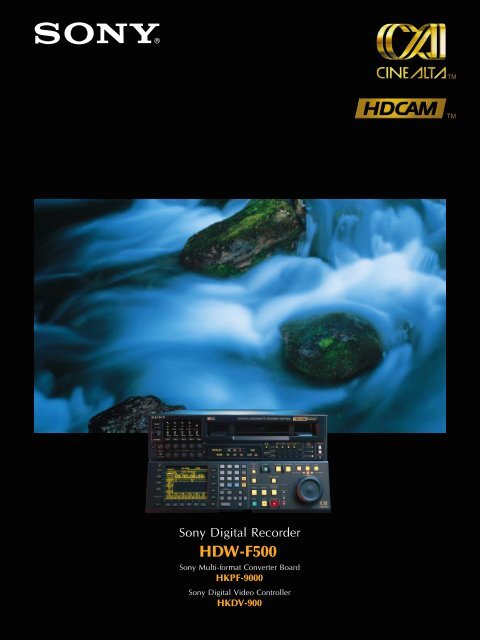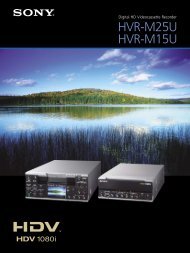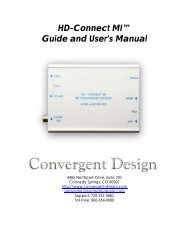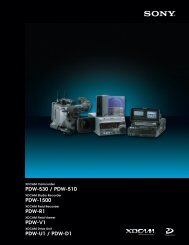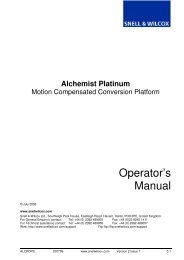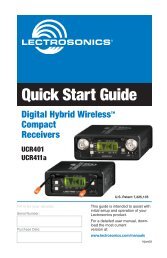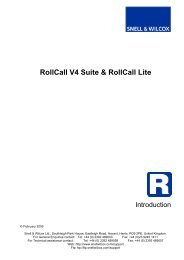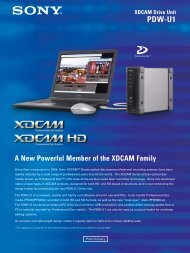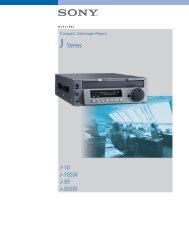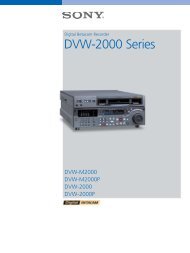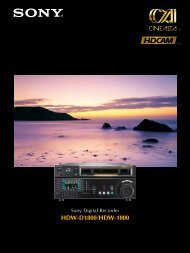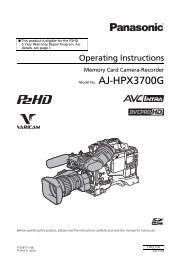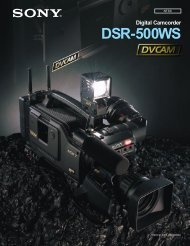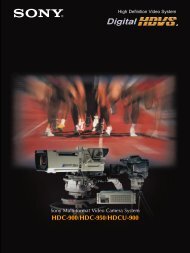HDW-F500 - GRS Systems
HDW-F500 - GRS Systems
HDW-F500 - GRS Systems
Create successful ePaper yourself
Turn your PDF publications into a flip-book with our unique Google optimized e-Paper software.
TM<br />
TM<br />
Sony Digital Recorder<br />
<strong>HDW</strong>-<strong>F500</strong><br />
Sony Multi-format Converter Board<br />
HKPF-9000<br />
Sony Digital Video Controller<br />
HKDV-900
Exploring New Horizons<br />
in Movie Making<br />
The Sony <strong>HDW</strong>-<strong>F500</strong> VTR defines a pivotal point in<br />
the development of digital recording. Based upon<br />
proven 1/2-inch tape technology the <strong>HDW</strong>-<strong>F500</strong> is the<br />
digital high definition recorder for production, post<br />
production, mastering and the preservation of precious<br />
archive material. Either on set or on location, it<br />
provides immediate playback of shots in the full,<br />
breath-taking high definition quality. View not just<br />
composition but details such as make-up and wardrobe<br />
exactly as they will be seen in the final production.<br />
But that’s not all. The <strong>HDW</strong>-<strong>F500</strong> is supremely<br />
flexible. Pictures are recorded according to the<br />
industry agreed Common Image Format (CIF) but can<br />
be acquired at a number of different frame rates. 24<br />
progressive frames per second (24P) to exactly match<br />
film production or switchable to 25P, 30P, 50<br />
interlaced (50i) or 60i to work with international<br />
Digital Television (DTV) standards. Simply stated this is<br />
the first singular digital format created specifically to<br />
suit the needs of Motion Picture, HDTV, DTV,<br />
Standard Definition TV, DVD, Internet, E-cinema and<br />
all other moving picture distribution channels.<br />
4
CineAlta — Liberating Movie Makers<br />
CineAlta – a name we proudly introduce to symbolize the bond<br />
between cinematography and Digital High Definition imaging. It<br />
distinguishes a Sony family of products and systems that offer new<br />
creativity in the production, post production and exchange of motion<br />
pictures. It brings together the quality and universality of 24-frame<br />
cinematography with the real-time capability, efficiency and<br />
flexibility of Digital High Definition technology. It stimulates the<br />
convergence of Motion Picture Film and Digital High Definition<br />
production on a global basis.<br />
CineAlta products, delivering cinema-quality pictures at selectable<br />
frame-rates, are simplifying International Programme Exchange by<br />
minimizing the need for standards conversion. Equally, they are<br />
opening up new possibilities for international co-production.<br />
Movie making has been liberated with the creative empowerment of<br />
the cinematographer. It is facilitated by real-time HD image<br />
evaluation on-set, instant replay of a full-color high-resolution digital<br />
“take”, real-time image optimization while shooting, a 50-minute<br />
shooting load and, most importantly, by the significant cost-benefits<br />
associated with this digital medium.<br />
CineAlta products also ensure a seamless bridge between 24-frame<br />
film originals and a final 24P digital master. A frame of film now has<br />
a one-to-one correspondence with a progressive HD frame. The<br />
CineAlta environment readily interfaces with the computer graphics<br />
world, liberating post production. The direct color conversion of<br />
progressive 24P masters to film, and to a multiplicity of international<br />
digital HDTV and SDTV distribution formats, are the final liberation.<br />
5
HDCAM – High Definition Digital Recording<br />
Since Sony introduced the HDCAM format in 1997, it<br />
has been well proven in the USA and Japan, where it<br />
has offered highly mobile and compact 1080/60i<br />
digital acquisition and recording solutions. This highly<br />
reliable and robust format delivers superb picture<br />
quality efficiently packaged onto 1/2-inch tape. The<br />
data rate is such that, compared to other systems, the<br />
tape recordings are inherently more robust and the<br />
running costs are lower due to lower tape consumption<br />
and reduced maintenance requirements. The data rate<br />
also makes possible portable, battery-powered<br />
products such as the <strong>HDW</strong>-F900 camcorder. Also the<br />
HDCAM signal (HDCAM-SDTI) can be routed through<br />
conventional SDI routers and infrastructure. Current<br />
computer graphic workstations can access the HD<br />
signal through their current SDI I/O.<br />
The <strong>HDW</strong>-<strong>F500</strong> VTR acquires each picture frame<br />
according to the industry standard Common Image<br />
Format (CIF) which specifies a sampling structure of<br />
1920 active pixels horizontally by 1080 pixels<br />
vertically.<br />
The state-of-the-art Sony HDCAM compression scheme<br />
is a frame-based digital compression strategy, where<br />
every frame of the signal is treated as a single entity.<br />
By this HDCAM maintains exceptionally high picture<br />
quality and multi-generation robustness for both<br />
progressive and interlace signals.<br />
Advanced digital pre-filtering and dynamic<br />
bit-allocation for luminance and chrominance<br />
components (based on the statistical analysis of the<br />
picture content) are combined with a low compression<br />
ratio of 4.4 to 1 to give a total on-tape recorded data<br />
rate of a modest 185 Mb/s at 60i. On tape the<br />
recordings are protected by very powerful error<br />
correction and concealment strategies perfected<br />
through years of Sony digital VTR development.<br />
The on-tape recording footprint remains the same for<br />
all frame rates. The different rates are accommodated<br />
by changing drum rotation speed and linear tape<br />
speed. What this means is that a recording made at<br />
one frame rate can easily be replayed at another frame<br />
rate with no quality loss. A 24P recording made to<br />
support movie production can be replayed at the<br />
slightly higher 25P and 30P frame rate for television<br />
broadcasting. A common practice made simple by the<br />
<strong>HDW</strong>-<strong>F500</strong>. In this case the <strong>HDW</strong>-<strong>F500</strong> will also<br />
convert audio and time code for correct 25P or 30P<br />
replay.<br />
7
The HDCAM format<br />
The HDCAM format maintains the same footprint for<br />
both progressive and interlaced signals. Every frame is<br />
treated as a single entity. Hence, recording of signals<br />
with different frame rates is achieved by efficient and<br />
automatic adjustment of the tape transport and drum<br />
rotation speeds. Each picture frame is recorded over 12<br />
helical tracks.<br />
The format also includes a newly developed digital<br />
signal processing with advanced error correction and<br />
error concealment. The error concealment system is<br />
powerful enough to provide superb picture quality<br />
even if one of the 4-playback heads is accidentally<br />
damaged. In addition, the 13.5 µm tape thickness<br />
ensures stable and reliable recording.<br />
24P HDCAM allows a single highest resolution<br />
program master to be created, from which all other<br />
video formats (or film recordings) can be made on a<br />
global basis. Simply stated, this is the first singular<br />
digital format ever created specifically to suit the needs<br />
of Motion Picture, HDTV, television, DVD, Internet,<br />
future E-Cinema and all other electronic and digital<br />
distribution media.<br />
In order to retain system compatibility of progressive<br />
frames with interlaced signals, the 24P system handles<br />
each progressive frame as two segments separated in<br />
time by 1/48th of a second. A complete progressive<br />
picture frame from the acquisition device (telecine,<br />
camcorder, studio camera, etc.) is divided into two<br />
segments and as such travels through the HD SDI<br />
base-band interface (or through the SDTI infrastructure<br />
in a compressed form) in the same manner as an<br />
interlaced signal. Although the segmented signal<br />
structurally resembles an interlaced signal, it should<br />
NOT be confused with interlaced images. The<br />
segmented frame format is approved by the ITU<br />
Rec.709-3 and is supported by most of the major<br />
manufacturers. The official ITU nomenclature for this<br />
signal is 24PsF – Progressive, Segmented Frames.<br />
8
Key Features<br />
Operational Flexibility and Production Convenience<br />
Conversion from HD to SD<br />
The HKDV-501A option provides down conversion capability from high<br />
definition (HD) to standard definition (SD). Standard definition serial digital<br />
(SDI) and analog composite signals are output. For a 60i or 30P recording 525<br />
signals are output. For a 50i or 25P recording 625 signals are output. Output<br />
of progressive standard definition signals (480P and 576P) is provided by<br />
means of dual linked SDI outputs.<br />
Down conversion from 24P is also possible with the addition of the optional<br />
HKDV-507 pull down board to provide the frame rate conversion. The frame<br />
rate conversion is achieved using the recognised 3-2 pull down sequence.<br />
The aspect ratio of the standard definition output can be selected from ‘Edge<br />
Crop’ (with adjustable position), ‘Letter box’ or ‘Squeeze’.<br />
A distinct advantage of the <strong>HDW</strong>-<strong>F500</strong> is that, with its down-conversion<br />
capability, the “super-sampled” HD origination produces standard definition<br />
480 and 576-line PAL/NTSC signals having technical performances that are<br />
superior to those were they originated in their native formats (their horizontal<br />
and vertical MTFs are higher and the associated scanning aliasing is less).<br />
24PsF<br />
25PsF<br />
30PsF<br />
Conventional 480/576-line<br />
Digital VTR<br />
”Super-sampled“ HDCAM<br />
Down-Converted signals<br />
Long Recording Time on a Single Cassette<br />
A full-length feature movie can be recorded on a single tape cassette. The<br />
<strong>HDW</strong>-<strong>F500</strong> supports both small and large tape cassettes. Small cassettes, as<br />
recorded by the Sony HDCAM camcorder – the <strong>HDW</strong>-F900 – and large<br />
cassettes ideal for production, post production and distribution. The actual<br />
running time is dependent upon the frame rate. Typically, at 24 progressive<br />
frames per second, a small cassette will record 50 minutes and a large cassette<br />
155 minutes.<br />
Digital Audio and Ancillary-Data Recording<br />
The HDCAM format records four channels (two AES/EBU stereo pairs) of<br />
non-compressed digital audio (20 bit at 48 kHz). The <strong>HDW</strong>-<strong>F500</strong> is able to<br />
record non-audio data streams within the audio recording area by packaging<br />
the data within an AES/EBU wrapper. Furthermore, the HDCAM footprint<br />
allows packets of Ancillary Data to be recorded in a dedicated portion of the<br />
Vertical Interval. This “Metadata” can consist of Closed Caption data, Film<br />
Metadata, or User Defined Data.<br />
High reliability is mandatory<br />
The <strong>HDW</strong>-<strong>F500</strong> bears a striking resemblance to the legendary Digital<br />
BETACAM TM studio VTRs. This resemblance is more than skin deep. The tape<br />
transport design is derived from Digital BETACAM thereby guaranteeing high<br />
reliability and familiar maintenance procedures.<br />
Dolby ® -E<br />
The Dolby-E system for digital surround sound production is gaining popularity<br />
and the <strong>HDW</strong>-<strong>F500</strong> can record the Dolby-E bit stream onto one of its AES/EBU<br />
stereo pairs. In total two Dolby-E bit streams can be recorded. In Playback the<br />
<strong>HDW</strong>-<strong>F500</strong> can compensate for the delay of the Dolby-E encoding/decoding<br />
process.<br />
*Dolby and the double-D symbol are trademarks of Dolby Laboratories Inc.<br />
9
Editing and Playback Functionality<br />
HEAD POSITION<br />
Pre-read Edit<br />
The <strong>HDW</strong>-<strong>F500</strong> is equipped with an advanced playback head to enable<br />
pre-read editing. This function allows users to edit with a single <strong>HDW</strong>-<strong>F500</strong><br />
and offers a cost-effective editing solution.<br />
Confidence Playback<br />
Separate playback heads immediately following the recording heads allow<br />
off-tape video and audio monitoring during recording. Therefore the quality of<br />
a recording can be immediately verified without stopping the production.<br />
Slow Motion Replay and Special Effects<br />
Using the Dynamic Tracking feature the <strong>HDW</strong>-<strong>F500</strong> is capable of noiseless,<br />
continuously variable picture replay in the range of –1 to +2 times normal<br />
playback speed. Ideal for slow motion, reverse action and reverse zoom shots.<br />
High Speed Picture Search<br />
Time is money and so the <strong>HDW</strong>-<strong>F500</strong> provides high speed picture search with<br />
recognizable color pictures up to +/- 60 time normal playback speed (24P<br />
mode).<br />
Digital Jog Sound<br />
Complete reproduction of all four channels of digital audio is possible within a<br />
range of –1 to +1 normal playback speed to allow the exact location of<br />
dialogue or music beats to be found.<br />
VITC (Vertical Interval Time-Code) Read/Write<br />
The <strong>HDW</strong>-<strong>F500</strong> can read and write time code at any speed. The VITC<br />
facilitates Play, Still, and Slow-motion all with precise time-code information.<br />
Advanced control panel<br />
The <strong>HDW</strong>-<strong>F500</strong> control panel will be familiar to many current operators, as it<br />
is similar to the advanced control panel of the Digital BETACAM VTRs. It<br />
incorporates direct access keys for rapid configuration and the facility to store<br />
machine set-ups and configurations on removable PCMCIA:SRAM memory<br />
cards.<br />
Video Remote Controller<br />
An optional video remote controller replicates the primary video image<br />
controls of the front panel onto a convenient remote panel.<br />
Versatile I/O capability<br />
The <strong>HDW</strong>-<strong>F500</strong> can be interfaced to its external environment at a number of<br />
levels.<br />
• HD-SDI input and outputs for digital, uncompressed, 10 bit component I/O<br />
conforming to SMPTE-292M with a bit rate of 1.5 Gb/s. These signals carry HD<br />
video, four channels of digital audio and auxiliary data.<br />
• SDTI input and outputs for digital HDCAM signals containing the compressed HD<br />
video and four channels of audio within the familiar 270 Mb/s standard SDI<br />
wrapper. This allows the HDCAM signals to be, for example, routed though<br />
existing SDI infrastructures or stored on conventional SDI based disc recorders.<br />
Using SDTI I/O perfect copies, or clones of material, with zero quality loss, can be<br />
made.<br />
• Analog composite outputs are available when the optional HKDV-501A down<br />
converter board is fitted.<br />
• Digital Audio I/O - two stereo pairs of AES / EBU digital audio I/O are available.<br />
• Analog Audio I/O - all four audio channels and the cue track are available on<br />
analog audio I/O. Two additional analog monitor audio outputs are included.<br />
• Reference – the <strong>HDW</strong>-<strong>F500</strong> can be synchronized to either 525, 625, 1125/59.94<br />
or 1125/60 reference signals.<br />
10
Key Features<br />
Options<br />
The operational flexibility of the recorder is enhanced by a comprehensive<br />
range of plug-in option boards:<br />
•HKDV-501A, High Definition to Standard Definition Down Converter Board<br />
•HKDV-502, HD Line Converter Board<br />
•HKDV-506A, SDTI Interface Board<br />
•HKDV-507, HD Pull-Down Board<br />
Content Information<br />
Content is king. It is the asset. What is it, where did it come from, how was it<br />
made? All valuable pieces of information. Using a system called Tele-File this<br />
information can be managed. Low cost cassette labels containing a memory<br />
IC, with contact-less, induction coil transmission, store the information. The<br />
<strong>HDW</strong>-<strong>F500</strong> can read and write from these labels and an additional<br />
reader/writer unit, for use under PC control, is available for stand-alone<br />
reading and writing.<br />
Contents Management with Tele-File<br />
11
Multi-format Conversion<br />
HKPF-9000 Sony Multi-format Converter Board enables<br />
cross-conversion between Standard Definition pictures<br />
and various-level HD formats. The HKPF-9000 and the<br />
<strong>HDW</strong>-<strong>F500</strong> can cover many of the video image<br />
formats currently in use worldwide. The matrix chart<br />
below summarizes the input/output conversion<br />
capability of the HKPF-9000. Some features and system<br />
configurations are described below.<br />
Installation Choice – PFV-HD300 or PFV-HD50A<br />
HKPF-9000 boards are housed in either a PFV-HD300 or PFV-HD50A HD<br />
Video Interface Unit. The 7RU PFV-HD300 holds up to four HKPF-9000<br />
systems, while the 3RU PFV-HD50A holds one system. Both these<br />
interface units can be used to hold other Sony HKPF Series boards, and both<br />
can be equipped with a redundant power supply unit to provide system<br />
reliability and operational stability.<br />
PFV-HD300<br />
PFV-HD50A<br />
Software Option for Step-by-Step Expandability<br />
When Sony started designing its new Multi-format converter, the key concept<br />
of “software function enhancement” was recognized as the way to combine<br />
low initial-cost with flexible system configurations. In its standard form, the<br />
HKPF-9000 provides 1080-line conversion to various SD picture formats.<br />
Optional software packages can then be added to expand the functionality of<br />
the HKPF-9000. When all the options are installed, the HKPF-9000 can cover<br />
the entire existing picture format and cross-convert among all of them. In<br />
combination with the <strong>HDW</strong>-<strong>F500</strong>, the HDCAM serves you as universal<br />
master.<br />
Furthermore, an important feature, which is called Selectable Colorimetry, is<br />
provided for Sony's new Multi-format Converter. With this function,<br />
colorimetry of the output pictures can be automatically adjusted according to<br />
HKPF-9000<br />
three calculating patterns – ITU-R BT.709, ITU-R BT.601-4 and SMPTE 240M<br />
– while keeping its overall RGB color balance. These three patterns can be<br />
interchanged as necessary, so that the outputs from the HKPF-9000 can always<br />
be conformed to each signal standard.<br />
1<br />
HZPF-9001, 720P Input Option<br />
4<br />
HZPF-9006, 1035/30P Input Option<br />
2<br />
3<br />
HZPF-9002, 480 Input Option<br />
HZPF-9003, 576 Input Option<br />
5 Standard configuration<br />
*Shaded areas indicate conversion is unavailable.<br />
12
Multi-format Conversion<br />
SDI-embedded Audio (Metadata) Handling<br />
and Time Code Conversion<br />
The HKPF-9000 Multi-format Converter separates audio and time code from<br />
the input stream, embedding the data again within the output signal.<br />
Non-audio data streams such as “Metadata” also follow this process. Set-up<br />
errors are reported to the user through a PC terminal, allowing reconfiguration<br />
of the device.<br />
Locking to External Reference Signal<br />
Output signals can be locked with an external reference. (1125/525/625<br />
SYNC)<br />
Selectable Picture Mode<br />
Three modes of operation enable correct picture presentation, depending on<br />
the application required.<br />
SQUEEZE mode<br />
LETTER BOX mode<br />
EDGE CROP mode<br />
HD to SD, 16:9 HD picture is down-converted and<br />
output as a 4:3 SD picture.<br />
HD to SD, 16:9 HD picture down-converted to SD and<br />
output is presented in Letter-box on a 4:3 monitor.<br />
HD to SD, edges of a 16:9 HD picture are cropped<br />
in the down-converted 4:3 SD picture.<br />
SD to HD, 4:3 SD picture is up-converted,<br />
then output as a 16:9 HD picture.<br />
SD to HD, 4:3 SD picture is cropped and<br />
presented as a 16:9 picture.<br />
SD to HD, 4:3 SD picture up-converted as a 16:9 HD<br />
picture, however the sides are cropped.<br />
Color Correction with Pan/Scan/Zoom/Crop Control<br />
Optional Aspect/Color Processor software, HZPF-9005, enables primary color<br />
correction and aspect ratio correction of pictures, which can be controlled<br />
from a PC terminal with comprehensive GUI.<br />
Other HKPF Boards Options:<br />
HKPF-103M, HD Digital Video Distribution Board<br />
HKPF-105M, HD A/V Multiplexer Board<br />
HKPF-106M, HD A/V Demultiplexer Board<br />
HKPF-525V/AV, HD-SD Component Serial Digital Converter Board*<br />
HKPF-1125A, NTSC-HD Up-converter Board*<br />
*This model may not be available in some countries. For the details, please contact your nearest Sony office.<br />
13
Image Enhancement and Video Level Control<br />
Image Enhancement and Video Level Control<br />
HKDV-900<br />
An optional HKDV-900 HD Digital Video Controller is<br />
designed to be used in conjunction with HKPF-9000,<br />
and enables various adjustments of the output<br />
including:<br />
Video Output Level Adjustment: For both HD and SD pictures, output<br />
video level of the HKPF-9000 can be adjusted. Parameters provided for these<br />
adjustments are:<br />
HD: Y (luminance) level, PB/PR (color difference) levels, Master level, Setup level,<br />
Sync phase<br />
D1: Y level, R-Y/B-Y levels, Master level, Sync phase, Cross color<br />
D2: Video level, Chrominance level, Setup level, Sync phase, Hue, Cross color<br />
Image Enhancement: Image enhancement may be performed within the<br />
HKPF-9000 in both up-conversion and down-conversion modes. Control is via<br />
HKDV-900. Functions include:<br />
H CROP: Adjust the horizontal position for cropping in Edge Crop mode.<br />
V LETTER: Adjust the vertical position of the sample area in Letter Box mode.<br />
DETAIL GAIN: Adjust the degree of detail edge enhancement.<br />
LIMITER: Adjust the maximum limit to the detail added to enhance the original<br />
signal.<br />
CRISP: Sets the amplitude level to ignore small-amplitude signals.<br />
DEPEND: Sets the luminance range for detail edge enhancement.<br />
FREQUENCY: Sets the center frequency for detail edge enhancement.<br />
H/V RATIO: Sets the ratio of horizontal and vertical edge enhancement.<br />
GAMMA: Sets the gradient of the gamma correction curve.<br />
Other Functions:<br />
Down-conversion/Up-conversion mode selection: As mentioned above, the<br />
picture modes (Squeeze, Letter Box or Edge Crop) can be remotely selected from<br />
the optional HKDV-900 Digital Video Controller.<br />
RS-422 Remote Control: You can use an optional Digital Video Controller Cable<br />
(D-sub 15-pin/9-pin, RCC-1502H/1505H/1510H/1530H) for direct connection to<br />
remotely control the Video Processor of an <strong>HDW</strong>-<strong>F500</strong> or <strong>HDW</strong>-500. Four<br />
connectors are provided on the rear panel of the HKDV-900, so that different<br />
settings can be applied to four VTRs.<br />
Memory Function for Adjustments and Settings: Up to 99 sets of settings can<br />
be saved in memory and recalled as necessary. Each set consists of the settings for<br />
each output signal and the system settings.<br />
Display Function for Adjustment and Settings: You can display the setting<br />
value for each adjustment parameter in the [MEMORY ADDR.] indicator on the<br />
front panel.<br />
*For the details, please refer to the operation instructions or service manuals.<br />
System Configuration<br />
14
One World – One Model<br />
All products with the CineAlta mark, are designed for<br />
world-wide use and for smooth, straightforward,<br />
international collaboration and program material<br />
exchange. This philosophy is embodied in the world’s<br />
first, truly global, HD VTR. The Sony <strong>HDW</strong>-<strong>F500</strong><br />
multi-frame-rate HDCAM Digital High Definition<br />
Recorder fully complies with the ITU 709-03 (1999)<br />
recommendation for High Definition Production and<br />
International Programme Exchange and can be<br />
switched to operate in any of the 50 and 60Hz regions<br />
of the world. In addition it can operate in accordance<br />
with the new 24P world production standard and<br />
deliver both a digital high definition signal output and<br />
simultaneously a digital standard definition signal<br />
output – ideal for future simul-casting.<br />
Optional Accessories<br />
HKDV-501A,<br />
High Definition to Standard<br />
Definition Down Converter Board<br />
HKDV-502,<br />
HD Line Converter Board<br />
HKDV-506A,<br />
SDTI Interface Board<br />
HKDV-507,<br />
HD Pull-down Board<br />
HKDV-900,<br />
Digital Video Controller<br />
BKDW-509,<br />
50-pin Parallel Remote Kit<br />
RMM-110,<br />
Rack Mount Kit<br />
BCT-124HDL/64HDL/40HD/22HD,<br />
HDCAM Video Cassette Tapes<br />
BCT-HD12CL,<br />
Video Head Cleaning Cassette Tapes<br />
HKPF-9000,<br />
Multi-format Converter Board<br />
PFV-HD300,<br />
HD Video Interface Unit<br />
PFV-HD50A,<br />
HD Video Interface Unit<br />
15
<strong>HDW</strong>-<strong>F500</strong> Specifications<br />
General<br />
Power requirements<br />
Power consumption<br />
Operating temperature<br />
Storage temperature<br />
Operating humidity<br />
Mass (Approx.)<br />
Dimensions (W x H x D)<br />
Tape speed<br />
Digital recording/Playback time<br />
Fast forward/rewind time<br />
Search speed range<br />
Servo lock time<br />
Load/unload time<br />
Input/output<br />
HD serial V/A input<br />
HD reference video input<br />
SD reference video input<br />
Digital audio input (CH1/2, CH3/4)<br />
Analog audio input (CH1/2/3/4/Cue)<br />
Time code input<br />
HD serial V/A output<br />
Pull-down output (Optional HKDV-507 required)<br />
Standard Definition V/A output<br />
(Optional HKDV-501A required)<br />
Analog I/O down converted output<br />
(Optional HKDV-501A required)<br />
Analog I/O reference output<br />
Digital audio output (CH1/2 CH3/4)<br />
Analog audio output (CH1/2/3/4/Cue)<br />
Monitor output (L/R)<br />
Time code output<br />
Phones<br />
SDTI input/output<br />
Remote 1 input<br />
Remote 1 output<br />
RS-232C<br />
Video control<br />
Parallel remote (Optional BKDW-509 required)<br />
Panel remote<br />
Digital video performance<br />
Sampling frequency<br />
Quantization<br />
Compression<br />
Channel coding<br />
Error correction<br />
Error concealment<br />
Analog composite output performance (With optional HKDV-501A)<br />
Bandwidth<br />
S/N ratio<br />
Y/C delay<br />
K Factor (2T Pulse)<br />
Output SCH phase<br />
Digital audio performance<br />
Sampling frequency<br />
Quantization<br />
Wow & flutter<br />
Headroom<br />
Emphasis<br />
Analog audio output performance<br />
A/D quantization<br />
D/A quantization<br />
Frequency response<br />
Dynamic range<br />
Distortion<br />
Cross talk<br />
Cue truck<br />
Frequency response<br />
S/N ratio<br />
Distortion<br />
Wow & flutter<br />
Supplied Accessories<br />
Optional Accessories<br />
100 to 240 V AC (±10 %, 50/60 Hz)<br />
230 W<br />
+ 5 °C to +40 °C (+41 °F to +104 °F)<br />
-20 °C to +60 °C (-4 °F to +140 °F)<br />
25 % to 80 % (Relative humidity)<br />
35 kg (77 lb. 2 oz)<br />
427 x 237 x 520 mm (16 3/4 x 9 3/8 x 20 1/2 inches)<br />
77.4 mm/s (24P mode)<br />
Max. 155 min with BCT-124HDL cassette (24P mode)<br />
Approx. 3 min with BCT-124HDL cassette<br />
±60 times normal playback speed (24P mode)<br />
1.0 sec or less (From standby on)<br />
6.0 sec or less<br />
BNC (x1 with a monitoring loop-through), Serial digital (1.485 Gb/s), SMPTE 292M/BTA S-004/ITU-R.BT 709<br />
BNC (x1, with a loop-through), Tri Level sync, 0.6 Vp-p, 75 Ω, sync negative<br />
BNC (x1, with a loop-through), Black Burst, 0.286 Vp-p, 75 Ω, sync negative<br />
BNC (x2, with 2 loop-through), AES/EBU<br />
XLR-5-pin type (Male)<br />
Low OFF: -60 dBu, high impedance, balanced<br />
High OFF: +4 dBu, high impedance, balanced<br />
High ON: +4 dBm, 600 Ω termination, balanced<br />
XLR-3-pin type, (Male x1), 0.5 to 18 Vp-p, 10 kΩ, balanced<br />
BNC (x4, with a character out), Serial digital (1.485 Gb/s), SMPTE 292M/BTA S004/ITU-R.BT 709<br />
BNC (x2), with character<br />
BNC (x3, with a character out), D1 serial digital (270 Mb/s), SMPTE 259M<br />
Composite: BNC (x1 with a character out) 1.0 Vp-p, 75 Ω, sync negative)<br />
SD sync: BNC (x1, Black Burst, 0.286 Vp-p, 75 Ω, sync negative)<br />
1125 Sync: BNC (x2), Tri Level sync, 0.6 Vp-p, 75 Ω, sync negative<br />
BNC (x2), AES/EBU, unbalanced<br />
XLR-3-pin type, (Female x5), +4 dBm, (With a 600 Ω load), low impedance, balanced<br />
XLR-3-pin type, (Female x2), +4 dBm, (With a 600 Ω load), low impedance, balanced<br />
XLR-3-pin type, (Female x1), 2.2 Vp-p low impedance, balanced<br />
JM-60 stereo phone jack, - ∞ to –12 dBu (With an 8 Ω load), unbalanced<br />
BNC (x2), Input/output, Serial digital<br />
D-sub 9-pin, Female, Sony 9-pin remote interface<br />
D-sub 9-pin, Female, Sony 9-pin remote interface<br />
D-sub 25-pin, Female<br />
D-sub 9-pin, Female (For optional HKDV-900)<br />
D-sub 50-pin, Female<br />
D-sub 15-pin, Female<br />
Y: 74.25 MHz, PB/PR: 37.125 MHz<br />
10 bits/sample of input-output signals (8 bit sample for internal compression process)<br />
Coefficient recording system<br />
S-NRZI PR-IV<br />
Reed-Solomon code<br />
Adaptive three dimensional<br />
Y: 0 to 5.75 MHz +5.0 dB/-3.0 dB<br />
56 dB or more<br />
15 ns or less<br />
1 % or less<br />
Based upon RS-170A/CCIR R.624-3<br />
48 kHz (Synchronized with video)<br />
20 bits/sample<br />
Below measurable level<br />
20 dB (Or 18 dB selectable)<br />
T1 = 50 µs, T2 = 15 µs (on/off selectable in recording mode)<br />
20 bits/sample<br />
20 bits/sample<br />
20 Hz to 20 kHz, +0.5 dB/-1.0 dB (0 dB at 1 kHz)<br />
More than 95 dB (At 1 kHz emphasis ON)<br />
Less than 0.05 % (At 1 kHz, emphasis ON, reference level)<br />
Less than –90 dB (At 1 kHz, between any two channels)<br />
90 Hz to 12 kHz ± 3 dB<br />
More than 45 dB (At 3 % distortion level)<br />
Less than 2 % (T.H.D at 1 kHz, reference level)<br />
Less than 0.2 % rms<br />
AC power cord (1) RCC-5G, 9-pin remote cable (1) PSW4 x 16screws, for rack mounting (4)<br />
SRAM 64 KB memory card (1) Operation manual (1) Maintenance manual part 1 (1)<br />
HKDV-501A, HD-SD Converter board HKDV-502, HD Line converter board<br />
HKDV-900, HD Digital Video Controller HKDV-506A, SDTI input and output board<br />
HKDV-507, HD Pull-down board BKDW-509, Parallel 50-pin interface kit<br />
RMM-110, Rack Mount Adapter BCT-HD12CL, Cleaning Cassette<br />
BCT-124HDL/64HDL/40HD/22HD, HDCAM tape cassette<br />
16
HKPF-9000 Specifications<br />
General<br />
Power requirements<br />
Power consumption (Approx.)<br />
Operating temperature<br />
Storage temperature<br />
Operating humidity<br />
Dimensions (Approx.)<br />
Mass (Approx.)<br />
Input<br />
SD digital signal input<br />
HD digital signal input<br />
Reference video input<br />
Output<br />
SD digital signal output<br />
HD digital signal output<br />
Remote<br />
RS-232C<br />
REMOTE IN<br />
VIDEO CONTROL<br />
ETHERNET*<br />
+ 5 V DC/4.0A, -5 V DC/3.0A (Supplied from PFV-HD300/HD50A)<br />
40 W<br />
+ 5 °C to +40 °C (+41 °F to +104 °F)<br />
- 20 °C to +55 °C (-4 °F to +131 °F)<br />
10 % to 90 % (Relative humidity)<br />
Board: 194 (H) x 310 (D) mm (7 3/4 x 12 1/4 inches)<br />
Connector panel: 25 (W) x 218 (H) x 98 (D) mm (1 x 8 5/8 x 3 7/8 inches)<br />
Board: 1400 g (3 lb. 2 oz)<br />
Connector panel: 600 g (1 lb. 6 oz)<br />
SDI IN 1 and 2: BNC type (x2), D1 Serial digital (270 Mb/s), SMPTE-259M, 75Ω, unbalanced,<br />
Return loss: 15 dB minimum (5 MHz to 270 MHz), Cable length: 200 m (660 feet) maximum (5C-2V cable)<br />
HD IN: BNC type (x1), Serial digital (1.485 Gb/s), SMPTE-291M • 292M • 299M/BTA S-004B • 005B • 006B/<br />
ITU-R.BT709, 75Ω, unbalanced, Return loss: 15 dB minimum (5 MHz to 1.485 GHz), Cable length: 100 m<br />
(330 feet) maxmum (5C-FB cable)<br />
REF IN: BNC type (x1, with a loop-through), HD tri-level sync or SD Black Burst (525/625), 75Ω, unbalanced,<br />
SDI OUT 1 and 2: BNC type (x2), D1 serial digital (270 Mb/s), SMPTE-259M, 75Ω, unbalanced,<br />
800mVp-p±10 %, Return loss: 15 dB minimum (5MHz to 270 MHz)<br />
HD OUT 1and 2: BNC type (x2), Serial digital (1.485 Gb/s), SMPTE-291M • 292M • 299M/BTA<br />
S-004B • 005B • 006B/ITU-R.BT709, 75Ω, unbalanced, 800mVp-p ± 10 %, Return loss: 15 dB minimum (5<br />
MHz to 1.485 GHz)<br />
D-sub 9-pin, Male<br />
D-sub 9-pin, Female, Sony 9-pin remote interface<br />
D-sub 9-pin, Female (For optional HKDV-900)<br />
10Base-T (x1)<br />
*Ethernet is a trademark of Xerox Corporation.<br />
HKDV-900 Specifications<br />
General<br />
Power requirements<br />
Power consumption<br />
Operating temperature<br />
Humidity<br />
Dimension (Approx.)<br />
Mass (Approx.)<br />
Connector<br />
REMOTE OUT (TO VTR)<br />
Supplied Accessories<br />
Optional Accessories<br />
100 to 240 V AC (±10 %, 50/60Hz)<br />
0.25A max. (AC 100V)/0.2A max. (AC 240V)<br />
+5 °C to +40 °C (+41 °F to +104 °F)<br />
20 % to 80 % (Relative humidity)<br />
424(W) x 44(H) x 171(D) mm (16 5/8 x 1 3/4 x 6 3/4 inches)<br />
2.9 kg (6 lb. 7oz)<br />
D-sub 15-pin, Female (x4)<br />
PSW4 x16 Screws, for Rack mounting (4)<br />
Operation manual (1)<br />
Installation Manual (1)<br />
RCC-1502H (2 m) • RCC-1505H (5 m) • RCC-1510H (10m) • RCC-1530H (30 m), Remote Control Cable<br />
17
© 2000 Sony Corporation. All rights reserved.<br />
Reproduction in whole or in part without the written permission of Sony is prohibited.<br />
Features and specifications subject to change without notice.<br />
All non-metric weights and measures are approximate.<br />
Sony and HDVS are registered trademarks of Sony Corporation, Japan.<br />
CineAlta, HDCAM, Digital BETACAM and Dynamic Tracking are trademarks of Sony Corporation, Japan.<br />
All other trademarks are property of their respective owners.<br />
24P is used as generic name in this literature, describing the Sony 24PsF method.<br />
Distributed by<br />
V-11121-A<br />
MK7536V3SMC00NOV<br />
Printed in Japan


